The Intel NUC8i7HVK (Hades Canyon) Review: Kaby Lake-G Benchmarked
by Ganesh T S on March 29, 2018 1:00 PM EST4K HTPC Credentials
The noise profile of the NUC8i7HVK is surprisingly good. At idle and low loads, the fans are barely audible, and they only kicked in during stressful gaming benchmarks. From a HTPC perspective, we had to put up with the fan noise during the decode and playback of codecs that didn't have hardware decode acceleration - 4Kp60 VP9 Profile 2 videos, for instance. Obviously, the unit is not for the discerning HTPC enthusiast who is better off with a passively cooled system.
Refresh Rate Accuracy
Starting with Haswell, Intel, AMD and NVIDIA have been on par with respect to display refresh rate accuracy. The most important refresh rate for videophiles is obviously 23.976 Hz (the 23 Hz setting). As expected, the Intel NUC8i7HVK (Hades Canyon) has no trouble with refreshing the display appropriately in this setting.
The gallery below presents some of the other refresh rates that we tested out. The first statistic in madVR's OSD indicates the display refresh rate.
Network Streaming Efficiency
Evaluation of OTT playback efficiency was done by playing back the Mystery Box's Peru 8K HDR 60FPS video in YouTube using Microsoft Edge and Season 4 Episode 4 of the Netflix Test Pattern title using the Windows Store App, after setting the desktop to HDR mode and enabling the streaming of HDR video.
The YouTube streaming test, unfortunately, played back a 1080p AVC version. MS Edge utilizes the Radeon GPU which doesn't have acceleration for VP9 Profile 2 decode. Instead of software decoding, Edge apparently requests the next available hardware accelerated codec, which happens to be AVC. The graph below plots the discrete GPU load, discrete GPU chip power, and the at-wall power consumption during the course of the YouTube video playback.
Since the stream was a 1080p version, we start off immediately with the highest possible bitrate. The GPU power consumption is stable around 8W, with the at-wall power consumption around 30W. The Radeon GPU does not expose separate video engine and GPU loads to monitoring software. Instead, a generic GPU load is available. Its behavior is unlike what we get from the Intel's integrated GPUs or NVIDIA GPUs - instead of a smooth load profile, it has frequent spikes close to 100% and rushing back to idle, as evident from the red lines in the graphs in this section. Therefore, we can only take the GPU chip power consumption as an indicator of the loading factor.
A similar graph for the Netflix streaming case (16 Mbps HEVC 10b HDR video) is also presented below. Manual stream selection is available (Ctrl-Alt-Shift-S) and debug information / statistics can also be viewed (Ctrl-Alt-Shift-D). Statistics collected for the YouTube streaming experiment were also collected here.
It must be noted that the debug OSD is kept on till the stream reaches the 16 Mbps playback stage around 2 minutes after the start of the streaming. The GPU chip power consumption ranges from 20W for the low resolution video (that requires scaling to 4K) to around 12W for the eventually fetched 16 Mbps 4K stream. The at-wall numbers range from 60W (after the initial loading spike) to around 40W in the steady state.
Update: I received a request to check whether the Netflix application was utilizing the Intel HD Graphics 630 for PlayReady 3.0 functionality. The screenshot below confirms that the 4K HEVC HDR playback with Netflix makes use of the Radeon RX Vega M GH GPU only.
Decoding and Rendering Benchmarks
In order to evaluate local file playback, we concentrate on Kodi (for the casual user) and madVR (for the HTPC enthusiast). Under madVR, we decided to test out only the default out-of-the-box configuration. We recently revamped our decode and rendering test suite, as described in our 2017 HTPC components guide.
madVR 0.92.12 was evaluated with MPC-HC 1.7.15 (unofficial release) with its integrated LAV Filters 0.71. The video decoder was set to Direct 3D mode, with automatic selection of the GPU for decoding operations. For hardware-accelerated codecs, we see the at-wall power consumption around 35-40W and the GPU chip power consumption to be around 10W. For the software decode case (VP9 Profile 2), the at-wall power consumption is around 90W, and the GPU chip power consumption is around 18W (the power budget is likely for madVR processing of the software-decoded video frames).
One of the praiseworthy aspects of the madVR / MPC-HC / LAV Filters combination that we tested above was the automatic switch to HDR mode and back while playing the last couple of videos in our test suite. All in all, the combination of playback components was successful in processing all our test streams in a smooth manner.
The same testing was repeated with the default configuration options for Kodi 17.6. The at-wall power consumption is substantially lower (around 30W) for the hardware-accelerated codecs. The GPU chip power is around 8W consistently for those. For the VP9 Profile 2 case, the at-wall number rises to 70W, but, there is not much change in the GPU chip power. We did encounter a hiccup in the 1080i60 VC-1 case, as the playback just froze for around 5 - 10s - evident in the graph below (the files were being played off the local SSD).
We attempted to perform some testing with VLC 3.0.1, but, encountered random freezes and blank screen outputs while using the default configuration for playing back the same videos. It is possible that the VLC 3.0.1 hardware decode infrastructure is not as robust as that of the MPC-HC / LAV Filters 0.71.0 combination, and the hardware acceleration APIs behave slightly differently with the Radeon GPU compared to the behavior seen with Intel's integrated GPU and NVIDIA's GPU.
Moving on to the codec support, while the Intel HD 630 is a known quantity with respect to the scope of supported hardware accelerated codecs, the Radeon RX Vega M GH is not. DXVA Checker serves as a confirmation for the former and a source of information for the latter.
We can actually see that the codec support from the Intel side is miles ahead of the Radeon's capabilities. It is therefore a pity that users can't somehow set a global option to make all video decoding and related identification rely on the integrated GPU.
Intel originally claimed at the launch of the Hades Canyon NUCs that they would be able to play back UltraHD Blu-rays. The UHD BD Advisor tool from CyberLink, however, presented a different story.
After a bit of back and forth with Intel, it appears that the Hades Canyon NUCs will not be able to play back UHD Blu-rays. Apparently, the use of the Protected Audio Video Path (PAVP) in the integrated GPU is possible only if the display is also being driven by the same GPU. It turned out to be quite disappointing, particularly after Intel's promotion of UHD Blu-ray playback and PAVP as unique differentiating features of the Kaby Lake GPU.










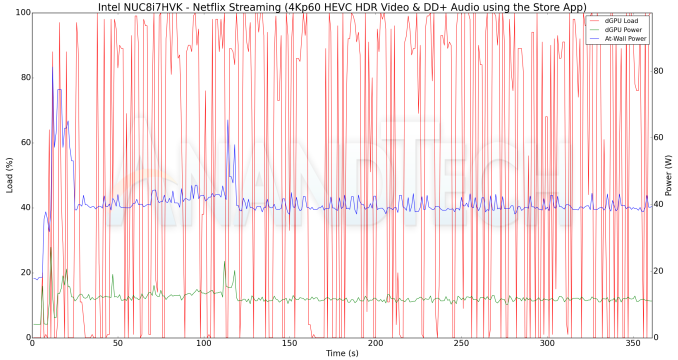
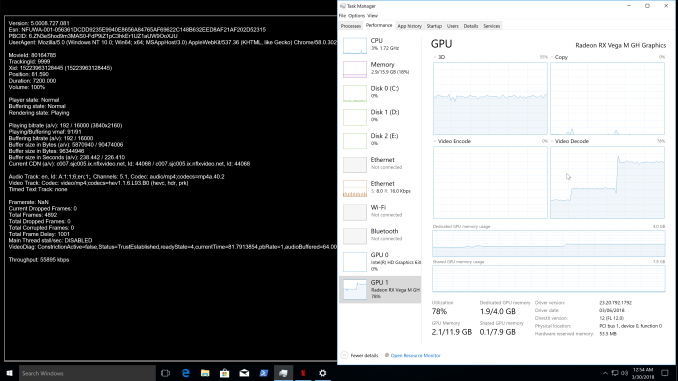
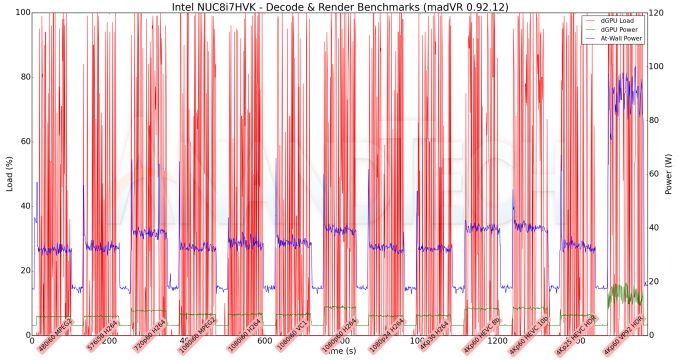
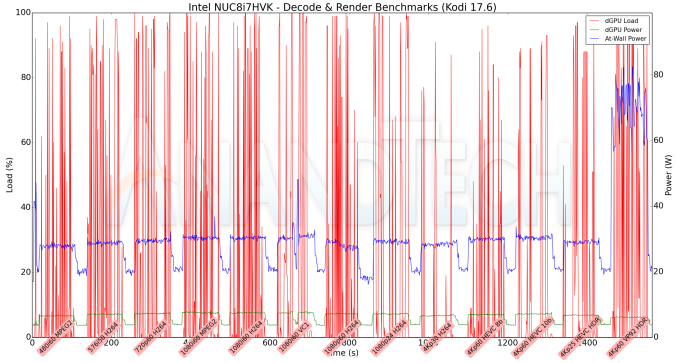
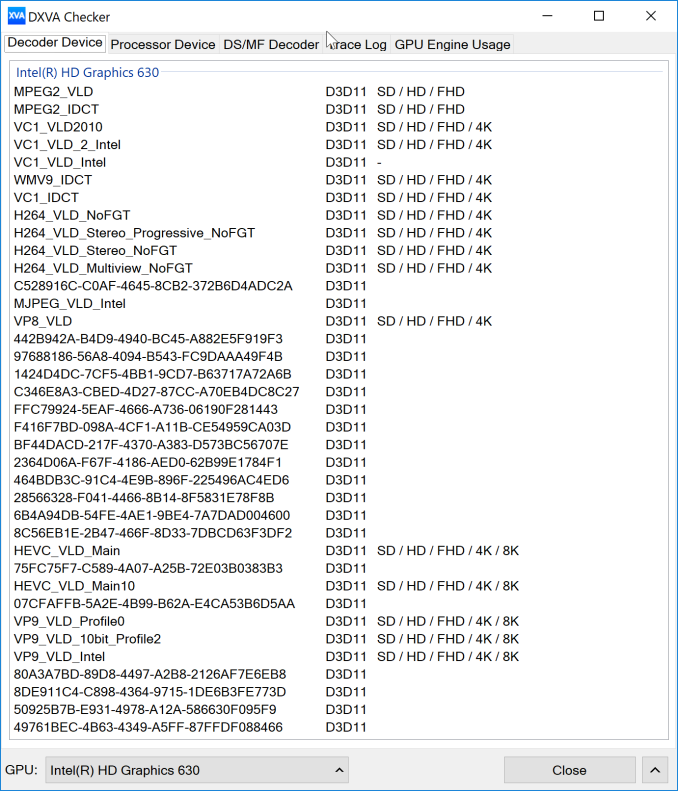
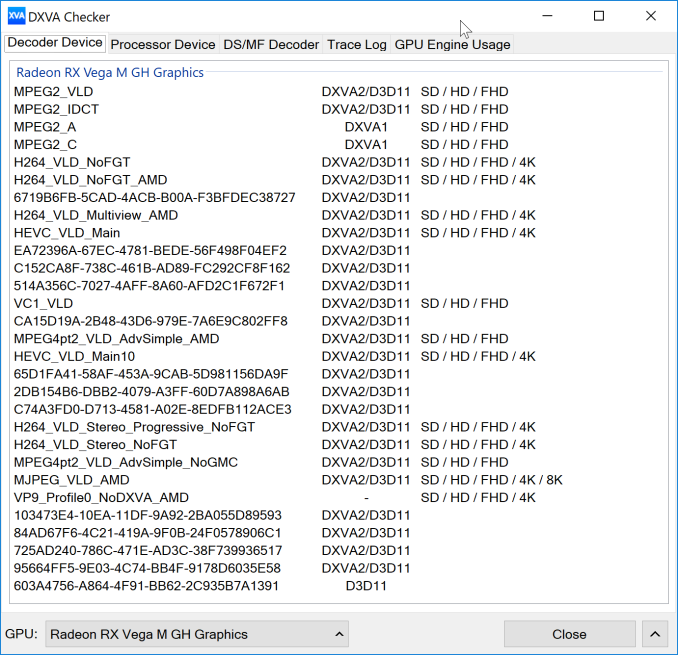
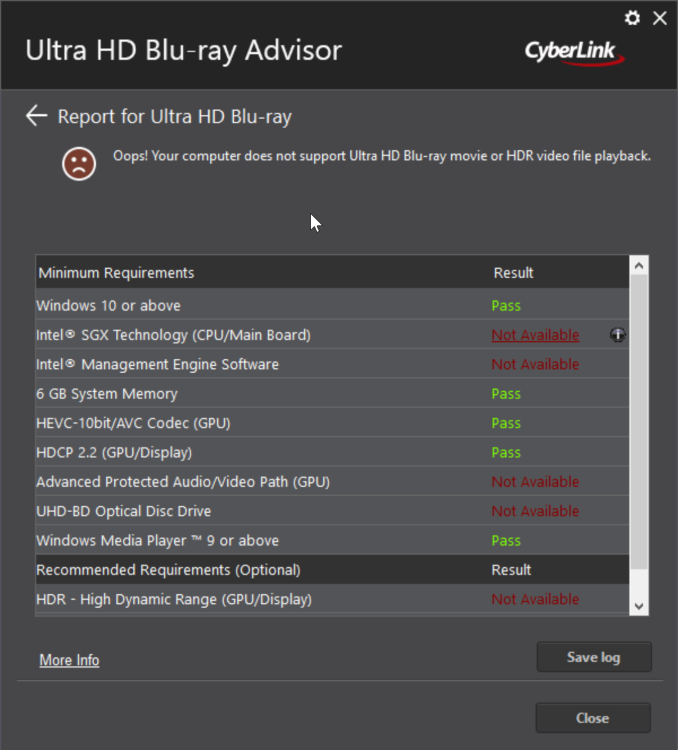








124 Comments
View All Comments
Hifihedgehog - Monday, April 2, 2018 - link
PS: Raven Ridge’s claim to fame is support for fixed function 10-bit VP9 decoding.tomshardware (dot) co (dot) uk/amd-ryzen-5-2400g-zen-vega-cpu-gpu,review-34205-4.html
kunal29 - Saturday, March 31, 2018 - link
What about the latency benchmarks between GPU and CPU?beginner99 - Sunday, April 1, 2018 - link
Not being able to play UHD BluRay basically kills the product as HTPC which limits it to gaming and that is a steep price to ask just for that. My effing TV can play 4k HDR but this $1300 PC can't???Tyler_Durden_83 - Monday, April 2, 2018 - link
Here is an idea, the benchmarks as images are so last decade, seeing the review of the zotac without the benchmarks of hades canyon just because it came out one day earlier, or with a terribly old xps 15 model even though you did bench the latest, is quite frankly not the high standard that people expect from Anandkmmatney - Monday, April 2, 2018 - link
This is a nice system, but still way too expensive. You can get a gaming laptop with 15" screen, 7700HQ cpu, RAM, Windows OS, usually an SSD OS drive, and a GTX 1060 for around this barebone price. Even less if you go for a 1050 Ti, which is about equivalent to this. It's impressive, but I just have never gotten the point of these expensive NUCs.JKJK - Tuesday, April 3, 2018 - link
lack of UHD/HDR support in many cases and those kodi freezes .... meh.I would like to see some update on these freeze-issues in the future.
HakkaH - Tuesday, April 3, 2018 - link
Too bad they didn't throw in the AMD 200G and 2400G with the benchmarks. You can build a small system with it which would be a whole lot cheaper and probably pretty decent when it comes to gaming speed.Dev3 - Thursday, April 5, 2018 - link
Hey Ganesh, can you comment on the current status of apparent lack of iGPU/AMD-CPU switchable graphics? Is this just an early BIOS/software issue or an unfixable design flaw where video-out is forced to route through the power-sucking Vega chip? This may be tolerable on a NUC but would be totally unacceptable on a laptop.I have an XPS-15 2-in-1 (9575) on order having assumed that Dell would never release a laptop with such a glaring flaw. But now with the first review out (https://www.digitaltrends.com/laptop-reviews/dell-... saying battery life is really bad, I'm getting concerned. Three hours runtime? Really??
I thought this was the laptop I was waiting for but now I'm seriously considering canceling my order before it ships and holding off until the issue is sorted out or at least understood.
I assume Intel is aware of the issue - can they fix it or did they (intentionally or unintentionally) sabotage their own (AMD) product??
AllThings3D - Saturday, April 7, 2018 - link
I noticed you only benchmarked the faster and more expensive NUC8i7HVK. Do you have any plans to benchmark the NUC8i7HNK? I have found very little on this unit and would love to know how much less is expected in performance. If we can obtain at least 50% over the equivalent KabyLake NUC with Iris 620 Graphics, this would be okay for my needs especially since the TDP is 65W versus 100W for the NUC8i7HVK. My purpose is to use this Microsoft Mixed Reality backpack PC with two Sony V-Lock or AntonBauer battery packs. My current NUC "belt system" using the Iris 620 IGPU has worked out very well for doing engineering and architectural VR visualization and with the MSXR using an unbounded positional tracking system, you can navigate larger spaces than with the current HTC/Vive systems. In this YouTube video (https://youtu.be/hM8uwzmhaJY) I am in my backyard, something I don't think I have seen done with the any of the other VR solution :)One more questions. Do you know what the actual VDC in range is? I know previous NUCs had an actual range between 11-24 VDC. Since the 'Belt System' uses a KabyLake NUC, the 14.8 VDC AntonBauer LiPo works great. I hope this is the case here since it would complicate my battery circuit to have have to go with a custom solution.
JKJK - Tuesday, April 10, 2018 - link
So... As a future proof media center (mostly kodi use), should I buy the previous gen?Need answer asap if I need to cancel my order